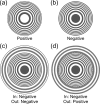Inverse-phase composite zone plate providing deeper focus than the normal diffraction-limited depth of X-ray microbeams
- PMID: 30655468
- PMCID: PMC6337886
- DOI: 10.1107/S1600577518016703
Inverse-phase composite zone plate providing deeper focus than the normal diffraction-limited depth of X-ray microbeams
Abstract
A novel type of zone plate (ZP), termed an inverse-phase composite ZP, is proposed to gain a deeper focus than the standard diffraction-limited depth of focus, with little reduction in spatial resolution. The structure is a combination of an inner ZP functioning as a conventional phase ZP and an outer ZP functioning with third-order diffraction with opposite phase to the inner ZP. Two-dimensional complex amplitude distributions neighboring the focal point were calculated using a wave-optical approach of diffraction integration with a monochromatic plane-wave illumination, where one dimension is the radial direction and the other dimension is the optical-axis direction. The depth of focus and the spatial resolution were examined as the main focusing properties. Two characteristic promising cases regarding the depth of focus were found: a pit-intensity focus with the deepest depth of focus, and a flat-intensity focus with deeper depth of focus than usual ZPs. It was found that twice the depth of focus could be expected with little reduction in the spatial resolution for 10 keV X-ray energy, tantalum zone material, 84 nm minimum fabrication zone width, and zone thickness of 2.645 µm. It was also found that the depth of focus and the spatial resolution were almost unchanged in the photon energy range from 8 to 12 keV. The inverse-phase composite ZP has high potential for use in analysis of practical thick samples in X-ray microbeam applications.
Keywords: depth of focus; diffraction limit; microbeam; spatial resolution; zone plate.
open access.
Figures








References
-
- Aoki, S., Ogata, T., Sudo, S. & Onuki, T. (1992). Jpn. J. Appl. Phys. 31, 3477–3480.
-
- Attwood, D. (1999). Soft X-rays and Extreme Ultraviolet Radiation, p. 361. Cambridge University Press.
-
- Born, M. & Wolf, E. (1986). Principles of Optics, 6th ed., p. 441. Oxford: Pergamon Press.
-
- Erko, A., Agafonov, Yu., Panchenko, L. A., Yakshin, A., Chevallier, P., Dhez, P. & Legrand, F. (1994). Opt. Commun. 106, 146–150.
-
- Henke, B. L., Gullikson, E. M. & Davis, J. C. (1993). At. Data Nucl. Data Tables, 54, 181–342.
Grants and funding
LinkOut - more resources
Full Text Sources
Molecular Biology Databases

